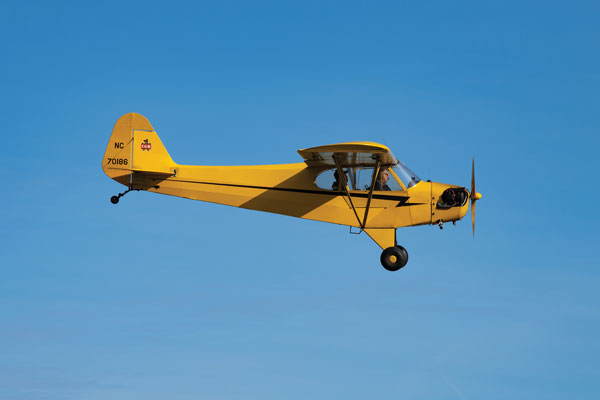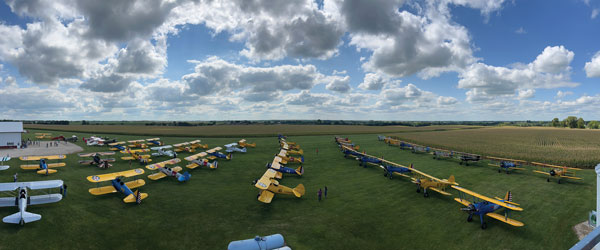
By Steve Krog, EAA 173799
This piece originally ran in Steve’s Classic Instructor column in the January 2024 issue of EAA Sport Aviation magazine.
According to the aviation dictionary, a bounced landing is the action of an aircraft that can develop after the aircraft landing gear touches the ground and the aircraft wheels repeatedly lose contact with the runway.
Several recent FAA accident/incident reports have focused on bounced landings and the end result. I’m sure you’ve all seen photos of airplanes pointed nose down with their tails high in the air.
It appears to me that little, if any, training time is spent on the proper and safe methods for handling a bounced landing. Beyond that, I wonder if anyone ever practices dealing with a bounced landing, or better yet, thinks through the proper action to take should one ever be experienced.
One afternoon last summer, a transient pilot flying a new Mooney called on the Hartford UNICOM stating he was entering the pattern and landing on Runway 27. Surface winds at the time were approximately 230 degrees at 12-15 knots, certainly not such that one would question landing with a crosswind.
Several of us were with students performing preflights in preparation for giving dual instruction in the J-3 Cubs. When the Mooney turned final, we paused to watch, and it soon became a teaching moment. That poor airplane bucked and hopped at least three times before a go-around was initiated. Hearing squealing tires, more people came out from the hangars to see what the commotion was all about.
The Mooney pilot decided to give the landing a second try. This time it was worse than the first attempt. Bucking and bouncing down the runway, it not only performed a series of bounces but also demonstrated how to “wheelbarrow” a tricycle-gear aircraft. We were all waiting for the sound of propeller metal contacting asphalt! After about the third bounce, power was added and a go-around was initiated.
A third attempt was then made. Bounces continued, but there was no wheelbarrowing. After using about 3,000 feet of the 3,400-foot runway, the Mooney came to a stop. Minutes passed, and then the pilot proceeded to taxi to the ramp. After shutting down the aircraft, the pilot exited the Mooney, walked toward us, and commented that he hoped we weren’t watching his feeble attempt at landing. He explained that he was a high-time professional pilot, had never flown a Mooney before, but was doing a self-checkout. Thankfully his first Mooney flight ended without damage!

What Leads to a Bounced Landing?
There are several factors that lead to a bounced landing. One is the inexperienced pilot. Though the individual mentioned in the above example was a high-time pilot, he had no experience in a Mooney.
The Mooney is a great single-engine aircraft, but like other aircraft makes and models, it has its own personality. Sitting low to the ground, it is prone to ground effect floating when attempting to land. What action does a pilot most often do in this situation? First, they will apply back-pressure on the yoke, which causes the aircraft to gain altitude.
Without thinking of the ramifications, they then push the yoke forward in an attempt to force the aircraft onto the runway. The nose wheel makes runway contact, which then scares the pilot. So they apply back-pressure to force the main gear onto the runway, but that lifts the nose. In this attitude, the aircraft is again generating lift and leaves the runway surface. The pilot relaxes the back-pressure, and the nose wheel again contacts the runway but at a steeper angle. Alarmed by the situation, the pilot again applies back-pressure but even more so. With the aircraft nose high once again, lift is generated until the wing stalls. Then BANG, the aircraft slams onto the runway.
Excessive airspeed on final approach can also factor into a bounced landing. Over the years of my flight experience, I’ve had the opportunity to ride in several different aircraft while conducting flight reviews. One of the questions I ask is what is the recommended approach speed for said aircraft. Often, I get a response stating the approach speed is 70 mph, for example, but the pilot always adds 10 more mph for “safety.”
Airspeed exceeding the manufacturer’s recommendations leads to long landings. Long landings lead to possible landing incidents. A long floating landing frequently causes the pilot to try and force the airplane onto the runway, especially if there is also a crosswind factor involved. The pilot is already uncomfortable dealing with the wind so they try to push the airplane onto the runway. When this occurs, a bounce is initiated.
Now the pilot is getting more uncomfortable and pushes the nose over in an attempt to get the airplane on the ground. But while doing so, the pilot takes all of the crosswind correction out of the landing. The airplane now is drifting precariously close to the runway edge just as the nose wheel followed by the main gear slams into the runway.
Panicked, the pilot slams the throttle to full power without correcting control inputs, and the aircraft exits the runway to the left, playing tag with runway lights and drainage ditches, all because of the fear of flying too slow!
While conducting flight training with students, I often see students attempting to force the airplane on the ground while dealing with a crosswind. Without training, students will almost always take out any crosswind correction as soon as the bounce occurs.
One or two attempts to land in this condition and configuration quickly teaches students to take proper action while continuing to fly the airplane. What is the recommended proper action? Smooth power application for a safe go-around.
Unstable approaches (airspeed, altitude, and attitude) also lead to bounced landings. If a pilot is unable to maintain a constant airspeed and descent angle, the landing will often turn into an unwanted event.
An unstable airspeed is a result of an unstable approach. We all know what happens when the approach airspeed is too fast. The airplane floats for hundreds, if not thousands of feet, before it is ready to settle on the runway.
During the float the pilot attempts to force the airplane down, leading to bounce after bounce after bounce, while hoping the bouncing will stop before significant damage is done.
Should the approach airspeed be too slow, even more damage could be done to the aircraft. Barely above stall speed, and usually below the desired glide path, the pilot applies back-pressure without the addition of some power. The airplane is now 10-15 feet above the runway and completely out of forward energy. It slams onto the runway with perhaps one ricocheting bounce, and there it sits. I’ve seen low-wing airplanes with dents in the top of the wing from a severe landing of this nature.
A stable approach is vital if a pilot is going to make consistently good and safe landings. At Cub Air, we push hard on our students to develop a feel for a stable approach and then use it consistently.
Our airport is a favorite for students and instructors from surrounding towered airports to practice touch-and-go landings. One thing I’ve observed over and over is the three-point touchdown on many landings. No flare is executed, and all three wheels slam onto the runway. Frequently, back-pressure is applied after dropping onto the runway, causing the airplane to lift back into the air and leading to the first of possibly many bounces.
This is exceedingly hard on the aircraft. Landing gear struts, nose wheel tires, and excessive use of brakes are all experienced in flat three-point bounced landings.
Corrective Action
What should you as a pilot do if experiencing a bounced landing? A good landing begins at the approximate mid-point on the downwind leg of the traffic pattern. If you’re in such a hurry that you must make a straight-in approach at the inconvenience of other pattern traffic, a bounced landing is imminent.
Starting at the downwind mid-point, is your altitude stable? Airspeed? Under normal pattern conditions, do you consistently reduce power at a particular point? Do you make the descending turn onto the base leg when at an approximate 45-degree angle off the approach end of the runway? At mid-point on base do you have 500 feet of altitude to work with? When on the final approach, do you have an aim point selected and try to fly your airplane to that point?
All these variables are vital to making not only a stable approach but also a good and safe landing.
If a bounce does occur, there are three actions that a pilot has available.
The first is no action. This leads to several more bounces and probably structural damage.
The second action depends on the pilot’s experience and the length of the runway being used. Immediately after the first bounce, apply approximately 300-500 rpm of additional power and stabilize the aircraft in a level attitude. Then, bleed the power back to idle and proceed with the flare and touchdown.
The third possible action is what we teach to all of our beginning students. If a bounce occurs, forget about trying to salvage a landing. Rather, smoothly apply full power, level the wings, and when fully under control, initiate a climb and go-around.
I constantly remind students that an FAA designated pilot examiner will never fail a student who opts for a go-around in recognition of an unstable approach or a bounced landing. But they will fail a student even if a good landing is salvaged from a poor or unstable approach.
When you next go for a pleasure flight, plan to make a go-around first from the flare attitude and then just after the wheels touch. Get to know how your airplane reacts in these situations. It may save you a lot of repair money someday.
Happy New Year and keep flying safely.
Steve Krog, EAA 173799, has been flying for more than four decades and giving tailwheel instruction for nearly as long. In 2006, he launched Cub Air Flight, a flight training school using tailwheel aircraft for all primary training.
Post Comments



